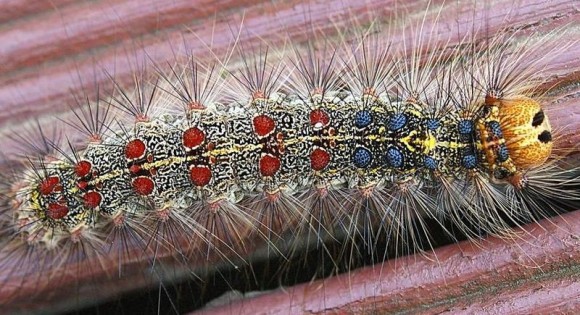
A Fauna the WSDA isn’t Too Fond Of
by: WSDA Pest Management Posted on: October 21, 2010
By Dr. James Marra, Managing Entomologist, Washington State Department of Agriculture
Keeping permanent populations of the destructive gypsy moth out of Washington is one of the great accomplishments of the Washington State Department of Agriculture (WSDA) during the past 36 years. If the pest were ever to become permanently established here – like it is in 19 states in the East and Midwest — the impact on Washington’s environment and economy would be catastrophic.
First detected in Washington in 1974, the moth is the worst forest pest insect ever brought to the U.S. In its caterpillar form, the pest aggressively attacks more than 500 species of trees and shrubs, destroying some and weakening others. In denuding trees of virtually all of their leaves, the moth has destroyed thousands of acres of wildlife habitat in the U.S., significantly degrading the water quality of creeks and streams, and reducing the use and aesthetic value of recreational areas.
Once established in an area, the gypsy moth spreads rapidly. One female moth can produce a thousand caterpillars in a single season. From a single property in Massachusetts in 1869, the pest is now permanently established on millions of acres in 19 states.
To keep the pest out of Washington, WSDA conducts early detection and rapid response programs. Each summer approximately 22,000 small, colorful, tent-shaped cardboard traps are placed around the state to detect gypsy moth activity. If multiple moths are caught in a small area, or other evidence of gypsy moth activity is noted, WSDA proposes an eradication treatment for the following spring.
If approved, the treatments take place in late April or early May, shortly after gypsy moth caterpillars hatch.
WSDA has conducted 85 eradication treatments. All have been successful. The first one occurred in 1979, the last one in 2007.
Several treatments are available to destroy gypsy moths. The most effective one used in recent years has been applications of the biological insecticide Bacillus thuringiensis var. kurstaki (Btk). Btk is a naturally occurring bacterial pathogen of the gypsy moth. Btk is found in soils and on plants throughout the world and widely used to eradicate insect pests. Widespread use of Btk against the gypsy moth began in the U.S. in the 1970s.
Numerous health studies show Btk to be a very low risk to human health. Also, Btk will not harm beneficial insects such as bees, lady beetle, ants, parasitic wasps, nor animals, birds, or fish.
The cost to taxpayers of WSDA’s gypsy moth detection and eradication programs is approximately $1 million a year. Of this amount, about half is provided by the federal government. In an average year, approximately 75 percent of gypsy moth control money is spent on summer trapping and 25 percent on eradication treatments.
Individuals interested in more information on gypsy moth control may visit the WSDA website at http://www.agr.wa.gov/PlantsInsects/InsectPests/GypsyMoth/default.aspx; or telephone the WSDA toll-free WSDA hotline at 1-800-664-8643.
3 Responses to “A Fauna the WSDA isn’t Too Fond Of”
Articles On Fauna
Fauna: Fauna
- Dec 4 Rapid Evolution and Adaptation to Climate Change: Salmon
- Sep 4 Orca Tribes of the Salish Sea and Beyond
- Jun 11 The Secret Life of Plastic
- Apr 29 The Tongass: The National Salmon Forest
- Jan 6 Oysters and Ocean Acidification
- Oct 6 Leave It to the Beaver!
- Sep 8 A New Trend in Dam Removal?
- Aug 31 There’s a New Bug in Town
- Jan 7 A History Lesson Concerning Fauna
- Oct 24 Salmon, Dams and the Snake River
- Oct 21 The Return of Washington’s Wolf Packs?
- Oct 21 A Fauna the WSDA isn’t Too Fond Of


by: radiology technicianon: Saturday 27th of November 2010
by: kill centipedeson: Tuesday 30th of November 2010
by: Nandargion: Wednesday 29th of August 2012